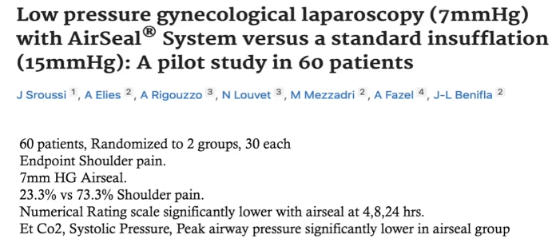Rana C. Pullatt, MD, FACS, FASMBS is the Professor of Surgery and Clinical Director of Bariatric and Robotic Surgery at the Medical University of South Carolina. He was also the 2023 Clinical Excellence Award Winner by the American society of Metabolic and Bariatric Surgery (ASMBS) Foundation.
Dr. Pullatt recently presented to a group of laparoscopic and robotic surgeons. This is a summary of his session.
AirSeal® has changed the operating environment for me.
A conventional insufflator pumps gas for three seconds, pauses to give intraabdominal reading, then pumps gas for 3 seconds and runs that same algorithm all case long.
AirSeal® pumps CO2 and constantly measures pressure and evacuates smoke. The continuous measurement of pressure results in a really stable pneumoperitoneum and a good operating environment.
Why low pressure insufflation?
The physiological basis behind low pressure laparoscopy is less diaphragmatic stretch, which results in less irritation and less pain. There’s also less bowing of the diaphragm into the thoracic cavity which decreases peak airway pressure and barotrauma.
The increase of intraabdominal pressure with high pressure insufflation is associated with hypertension and in obese patients it increases the activation of the renin angiotensin system, increasing the blood pressure even further.
What do you set your intraabdominal pressure to?
In this case, you can see an exampleof us using AirSeal®. The pressure is set to 6-8 mmHg, and you can see the amount of surgical exposure. When you’re closing the diaphragmatic crura, having a lower pressure really helps. It prevents the diaphragm from being too distracted, and as you can see, operating at 8 or 7 mmHg is perfectly doable in these cases.
What is the clinical evidence behind operating at low pressure with AirSeal®?
There have been several studies, but this randomized pilot study looked at pain. They split patients into two groups - one group was operated on with AirSeal® at 7mmHg and one group with 12-15 mmHg.

Another study concluded similar results, showing:2
- Lower pain scores
- Lower peak airway pressure
- Lower endtidal CO2
- Lower systolic blood pressure
In General Surgery the results have translated well; in lap cholecystectomy it’s showing the same reduction in pain, which was statistically significant. In the Bariatric world, using AirSeal® is resulting in the same trends.
Do you use AirSeal® in every case?
I use AirSeal® in every case. It truly has changed my life...once you embrace it, it’s very hard to go back. The field is a lot cleaner. If you get into a bleeding situation you can generally use suction and not have to worry about it collapsing and still have control.
To watch Dr. Pullatt’s full presentation, including his operative technique for SADI and Robotic Remnant Cholecystectomy, click here.
To learn more about the AirSeal® iFS, click here.
1 Sroussi J, Elies A, Rigouzzo A, et al. Low pressure gynecological laparoscopy (7mmHg) with AirSeal® System versus a standard insufflation (15mmHg): A pilot study in 60 patients. J Gynecol Obstet Hum Reprod. 2017;46(2):155-158. doi:10.1016/j.jogoh.2016.09.003
2 Buda A, Di Martino G, Borghese M, et al. Low-Pressure Laparoscopy Using the AirSeal® System versus Standard Insufflation in Early-Stage Endometrial Cancer: A Multicenter, Retrospective Study (ARIEL Study). Healthcare (Basel). 2022;10(3):531. Published 2022 Mar 14. doi:10.3390/healthcare10030531
